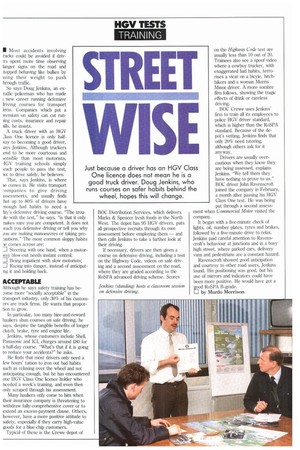STREET
Page 31

If you've noticed an error in this article please click here to report it so we can fix it.
vs' SE Just because a driver has an HGV Class One licence does not mean he is a good truck driver. Doug Jenkins, who runs courses on safer habits behind the wheel, hopes this will change.
I Most accidents involving nicks could be avoided if drivTs spent more time observing Langer signs on the road and topped behaving like bullies by ising their weight to push hrough traffic.
So says Doug Jenkins, an exraffle policeman who has made new career running defensive hiving courses for transport irms. Companies which put a wemium on safety can cut nulling costs, insurance and repair Ws, he insists.
A truck driver with an HGV :lass One licence is only halfway to becoming a good driver, ;ays Jenkins. Although truckers end to be more courteous and ;ensible than most motorists, -IGV training schools simply each people to pass the test, lot to drive safely, he believes.
That, says Jenkins, is where le comes in. He visits transport :ompanies to give driving issessments, and usually finds hat up to 80% of drivers have enough bad habits to need a lay's defensive driving course. "The trou)1e with the test," he says. "is that it only nakes sure you are competent. It does not :each you defensive driving or tell you why ,rou are making manoeuvres or taking precautions." 'Ile most common sloppy habits le comes across are:
II Steering with one hand, when a motorNay blow-out needs instant contra Being impatient with slow motorists; Racing into danger, instead of anticipatng it and holding back.
ACCEPTABLE
Although he says safety training has become more "socially acceptable" in the transport industry, only 30% of his customers are truck firms. He wants that proportion to grow.
In particular, too many hire-and-reward hauliers shun courses on safe driving, he says, despite the tangible benefits of longer clutch, brake, tyre and engine life.
Jenkins. whose customers include Shell, Panasonic and charges around £80 for a half-day course. "What's that if it is going to reduce your accidents?" he asks.
He finds that most drivers only need a few hours' tuition to iron out bad habits such as relaxing over the wheel and not anticipating enough, but he has encountered one IIGV Class One licence holder who needed a week's training, and even then only scraped through his assessment.
Many hauliers only come to him when their insurance company is threatening to withdraw fully-comprehensive cover or to extend an excess-payment clause. Others, however, have a more positive attitude to safety, especially if they carry high-value goods for a blue-chip customers.
Typical of these is the Crewe depot of BOC Distribution Services, which delivers Marks & Spencer fresh foods in the North West. The depot has 95 HGV drivers, puts all prospective recruits through its own assessment before employing them — and then calls Jenkins to take a further look at their driving.
If necessary, drivers are then given a course on defensive driving, including a test on the Highway Code, videos on safe driving and a second assessment on the road, where they are graded according to the RoSPA advanced driving scheme. Scores
on the Highway Code test are usually less than 10 out of 20. Trainees also see a spoof video where a cowboy trucker, with exaggerated bad habits, terrorises a vicar on a bicyle, hitchhikers and a woman Morris Minor driver. A more sombre film follows, showing the tragic effects of drink or careless driving.
BOC Crewe uses Jenkins' firm to train all its employees to police HGV driver standard, which is higher than the RoSPA standard. Because of the depot's vetting, Jenkins finds that only 20% need tutoring, although others ask for it anyway.
Drivers are usually overcautious when they know they are being assessed, explains Jenkins. "We tell them they have nothing to prove to us." HOC driver John Ravenscroft joined the company in February, a month after passing his HGV Class One test. He was being put through a second assessment when Commercial Motor visited the company.
It began with a five-minute check of lights, oil, number plates, tyres and brakes, followed by a five-minute drive to relax. Jenkins paid careful attention to Ravenscroft's behaviour at junctions and in a busy high street, where parked cars, delivery vans and pedestrians are a constant hazard.
Ravenscroft showed good anticipation and courtesy to other road users, Jenkins found. His positioning was good, but his use of mirrors and indicators could have been more positive. He would have got a mod RoSPA B-grade.
LJ by Murdo Morrison




































































































